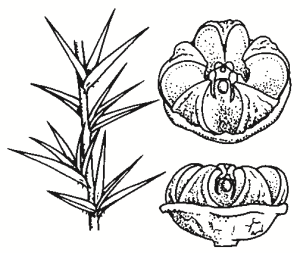Family:
Myrtaceae
Leptospermum continentale
Prickly Tea-tree
(syn. L. juniperinum)
Other Names:

Name Origin:
Leptospermum — from Greek leptos, slender, and sperma, seed, referring to narrow seeds of some species.
continentale — refers to its mainland distribution as opposed to its close relative Manuka (L. scoparium), which only occurs in Tas and NZ.
Regional Subspecies:
Occurrence:
Regional:
Widespread east of the Olympic Highway.
Australia:
NSW, Vic, SA.
Habitat:
Forest or open sandy swampy places.
Habit:
Upright rigid prickly shrub 1-2 m high. Firm bark and narrow green leaves.
Site Preference:
Poorly-drained soil such as seepages. Tolerates frost and extended dry periods.
Characteristics:
Very hardy. Moderate growth rate. Lifespan up to several decades.
Flowering:
White, or rarely pink, Oct-Jan.
Seed Collection:
Any time. Seeds retained for many years, only shed after adversity such as injury, drought or fire. Collect capsules from older wood. Seeds highly viable, remaining so for many years in storage.
Propagation:
From seed or tip cuttings. Smoke treatment further improves germination. Sow light scattering of seed and cover lightly. Germinates in 2-5 weeks. Capillary watering should benefit fine seed. Suitable for direct seeding into pots.
Regeneration:
From seed, suckers and lignotubers. Regenerates quickly after soil disturbance.
VALUES:
Shade & Shelter:
Useful low-level cover in windbreaks, particularly on poorly drained sites.
Land Protection:
Useful in controlling erosion due to soil-binding fibrous roots, and for revegetating swampy areas.
Wildlife:
Excellent habitat. Prickly foliage excellent refuge for small birds, particularly dense thickets. Flowers are a good pollen and nectar source for many native insects, including moths and butterflies.
First Nations:
Implements made from stems, including pegs for kangaroo skins, hunting spears and eel spears.
Ornamental:
Attractive, particularly when planted to form dense thickets. Flowers prolifically. Prune from early age to encourage bushiness.
Other:
Stems used for tea-tree fencing and for plant stakes. Used in colonial medicine.
